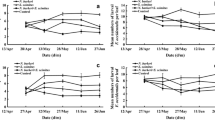Abstract
A series of experiments was initiated on ‘Tahiti’ lime trees to assess possible involvement in yield reduction by one or more species of thrips, especially Frankliniella bispinosa (Morgan) and F. kelliae Sakimura (Thysanoptera: Thripidae). Different pesticides were applied to ensure adequate coverage on flowers and to maintain effective thrips control. Outbreaks of spider mites were anticipated because of the pesticides used and frequency of application. Therefore, population dynamics of the citrus red mite, Panonychus citri (McGregor) (Acari: Tetranychidae) and the predacious mites Typhlodromalus peregrinus (Muma) (Acari: Phytoseiidae) and Agistemus floridanus Gonzalez (Acari: Stigmaeidae) were monitored in four pesticide treatment regimes during flowering on ‘Tahiti’ lime, Citrus latifolia Tanaka in south Florida. Yield was significantly reduced in four pesticide treatment regimes by 41, 31, 28 and 17% relative to the untreated control. Elimination of predacious mites by the selected pesticides resulted in higher sustained populations of P. citri on treated trees compared to those untreated. The pesticide regimes resulted in differences in population densities of both citrus red mite and its key predators. Depending upon the treatment regime and application date(s), the duration and magnitude of disruption resulted in significant differences in yield. P. citri densities that averaged 5.2 or more per leaf during January–February, or 4.3 or more per leaf during January–March, or 3.9 or more per leaf during January– April contributed substantially to the feeding injury and resulted in reduced yield. Typhlodromalus peregrinus was the most common predacious mite collected during this study (80.4%) followed by A. floridanus with 15.7%.
This study demonstrated that the use of one or more pesticides on ‘Tahiti’ lime trees can negatively impact populations of citrus red mites and their associated predators to the detriment of yield. The magnitude of impact was dependent upon the treatment regime and application date(s). Spider mites increased because of reduced predator populations and use of these pesticides, especially in combination, is to be discouraged.
Similar content being viewed by others
References
Brown, A.E., Sreenivasaprasad, S. and Timmer, L.W. 1996. Molecular characterization of slow-growing orange and Key lime anthracnose strains of Colletotrichum from citrus as C. acutatum. Phytopathology 86, 523–527.
Bullock, R.C., Childers, C.C., Hall, D.G., Knapp, J.L., McCoy, C.W., Rogers, J.S. and Stansly, P.A. 1998a. Citrus rust mite. In: 1998 Florida Citrus Pest Management Guide, SP-43, J.L. Knapp (ed.), pp. 15–19. Univ. Florida Coop. Ext. Serv.
Bullock, R.C., Futch, S.H., Knapp, J.L. and McCoy, C.W. 1998b. Citrus root weevils. In: 1998 Florida Citrus Pest Management Guide, SP-43, J.L. Knapp (ed.), pp. 28–30. Univ. Florida Coop. Ext. Serv.
Childers, C.C. 1992. Suppression of Frankliniella bispinosa (Thysanoptera: Thripidae) and the fungal pathogen Colletotrichum gloeosporioides, with pesticides during the bloom cycle and improved fruit set on ‘navel’ orange in Florida. J. Econ. Entomol. 85, 1330–1339.
Childers, C.C. and Beshear, R.J. 1992. Thrips (Thysanoptera) species associated with developing citrus flowers in Florida and a key to adult Terebrantian females. J. Entomol. Sci. 27, 392–412.
Childers, C.C., Beshear, R.J., Brushwein, J.R. and Denmark, H.A. 1990. Thrips (Thysanoptera) species, their occurrence and seasonal abundance on developing buds and flowers of Florida citrus. J. Entomol. Sci. 25, 601–614.
Childers, C.C. and Enns, W.R. 1975. Field evaluation of early season fungicide substitution on tetranychid mites and the predators Neoseiulus fallacis and Agistemus fleschneri in two Missouri apple orchards. J. Econ. Entomol. 68, 719–729.
Gilstrap, F.E. and Browning, H.W. 1983. Sampling predaceous mites associated with citrus. Texas Agric. Exp. Sta. PR-4139. 5 pp.
Hare, J.D., Pehrson, J.E., Clemens, T., Menge, J.A., Coggins, Jr., C.W., Embleton, T.W. and Meyer, J.L. 1990. Effects of managing citrus red mite (Acari: Tetranychidae) and cultural practices on total yield, fruit size and crop value of ‘navel’ orange. J. Econ. Entomol. 83, 976–984.
Hare, J.D., Pehrson, J.E., Clemens, T., Menge, J.A., Coggins, Jr., C.W., Embleton, T.W. and Meyer, J.L. 1992. Effect of citrus red mite (Acari: Tetranychidae) and cultural practices on total yield, fruit size and crop value of ‘navel’ orange: years 3 and 4. J. Econ. Entomol. 85, 486–495.
Hare, J.D. and Phillips, P.A. 1992. Economic effect of the citrus red mite (Acari: Tetranychidae) on southern California coastal lemons. J. Econ. Entomol. 85, 1926–1932.
Hull, L.A. and Beers, E.H. 1990. Validation of injury thresholds for European red mite (Acari: Tetranychidae) on ‘Yorking’ and ‘Delicious’ apple. J. Econ. Entomol. 83, 2026–2031.
Jeppson, L.R., Keifer, H.H. and Baker, E.W. 1975. Mites injurious to economic plants. Univ. California Press, Berkeley.
McMurtry, J.A. 1985. Citrus. In: spider mites their biology, natural enemies and control. Vol. 1B, W. Helle and M. Sabelis (eds), pp. 339–347. Elsevier, Amsterdam.
Muma, M.H. 1967. Typhlodromalus peregrinus (Muma) (Acarina: Phytoseiidae) on Florida citrus. Proc. 2nd Intern. Cong. Acarol. pp. 135–148.
Muma, M.H. 1975. Mites associated with citrus in Florida. Univ. Florida Agric. Exp. Sta. Bull. 640A.
Pena, J.E., Baranowski, R.M. and Denmark, H.A. 1989. Survey of predators of the broad mite in southern Florida. Florida Entomol. 72, 373–377.
SAS Institute. 1991. SAS Language and procedures: Usage 2, version 6, first edition. SAS Institute. Cary, N.C.
Smitley, D.R., Brooks, W.M. and Kennedy, G.G. 1986. Environmental effects on production of primary and secondary conidia, infection, and pathogenesis of Neozygites floridana, a pathogen of the two spotted spider mite, Tetranychus urticae. J. Invert. Pathol. 47, 325–332.
Sonoda, R.M. and Pelosi, R.R. 1988. Characteristics of Colletotrichum gloeosporioides from lesions on citrus blossoms in the Indian River area of Florida. Proc. Florida State Hort. Soc. 101, 36–38.
Thompson, W.T. 1994–95. Insecticides, Acaricides and Ovicides. Agricultural Chemicals Book I. Thompson Pub., Fresno, CA.
Wrensch, D.L. 1985. Reproductive parameters. In: Spider mites their biology, natural enemies and control. Vol. 1A, W. Helle and M.W. Sabelis (eds), pp. 165–170. Elsevier, Amsterdam.
Rights and permissions
About this article
Cite this article
Childers, C., Abou-Setta, M. Yield Reduction in ‘Tahiti‘ Lime from Panonychus Citri Feeding Injury Following Different Pesticide Treatment Regimes and Impact on the Associated Predacious Mites. Exp Appl Acarol 23, 771–783 (1999). https://doi.org/10.1023/A:1006285209533
Issue Date:
DOI: https://doi.org/10.1023/A:1006285209533




